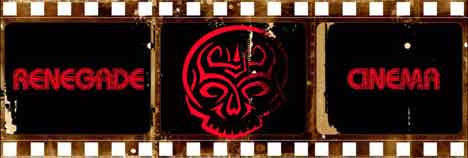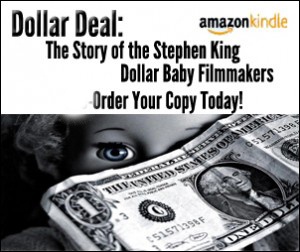So, you said you are working on something new now and it is not an action movie, what is coming up next?
Adam: Well, we are half way through. We are shooting a pilot episode for like a web/television series, because it is longer than a typical web series. But, it is called Rough Cut. It is about independent filmmakers in Oklahoma, and what we are. That sounds a bit cliché, but with the people we have encountered, and the process we have encountered here, and the insanity that often, frequently accompanies filmmaking here, we think it is kind of a unique endeavor so we are putting together a web series chronicling these filmmakers trying to make a film in Oklahoma with no money. Ultimately, like Charlie is about more than superheroes, ultimately it is about loyalty and under doggedness, you know and the pursuit of happiness.
 Kenny: And we are using a lot of local Oklahoma filmmaker stuff. as far as shirts and posters.
Kenny: And we are using a lot of local Oklahoma filmmaker stuff. as far as shirts and posters.
Adam: We are really trying to integrate other filmmakers, other projects, not that anybody in Austin is going to know the difference, but to make it so it really, really speaks to people here. Obviously that is not the end goal, but it is legitimate to the filmmaking here because there are a lot of people putting together projects, so we are trying to acknowledge that.
Chad: The assumption being that it is not all that different than it would be for a group of people in Austin that are making film, or in Missouri or wherever. It would be the same situation, same things you have to go through, try to make a feature length movie that is really too big for the resources that you have but you do it anyway.
You mentioned that you raised the money for Charlie Christmas through Kickstarter?
Chad: It is an amazing resource for filmmakers like us, if it wouldn’t have been for that, we wouldn’t…
Adam: Between that and social media, Kickstarter and Facebook have completely revolutionized – at least what we do, at the level we are at, is because of it.
Chad: We have done event driven fundraisers, garage sales, and silent auctions and that kind of stuff. But, by far, the Kickstarter stuff, I think it was – what 10 days? – and we had already almost met our goal.
 Jason: I mean, it is the easiest when it comes to it because you are talking about the other stuff we do, you know you have to put work into it, even though it is a silent auction, you have to go do it. With Kickstarter, you sit down, type it all up, you shoot a video maybe, and you push it out there through social media, I mean there is not a lot of leg work to it really, so…
Jason: I mean, it is the easiest when it comes to it because you are talking about the other stuff we do, you know you have to put work into it, even though it is a silent auction, you have to go do it. With Kickstarter, you sit down, type it all up, you shoot a video maybe, and you push it out there through social media, I mean there is not a lot of leg work to it really, so…
Kenny: I think the one drawback with Kickstarter, at least for us, I see going into the future is that the money we made was largely from family and friends and our network. Now, we are growing that network, because we are growing what we do and who we know, and our social media fan base has gotten bigger, so that helps out. But, I think there is a saturation point where if you want to continue to do something, like for instance with Rough Cut, if we tried to raise money through Kickstarter again it might be a little bit different experience. A little bit harder, maybe, depending on how well you grow your audience online, I think.
I don’t know if you know Kyle Roberts, he is also shooting a superhero movie here in Oklahoma.
ADAM: Is it called Posthuman?
Yes, and they have the IndieGoGo fundraising platform that they went through to raise money, as well as benefit concerts, so it seems that there are a lot of ways to raise money to do this. When I first started, when I was in film school back in 2000, these online things really didn’t exist. I bartended through the entire year to save money to go do something at the end of the year.
Chad: You get a credit card and max it out.
Exactly.
Chad: That is the way it used to be done.
Adam: Either that, or I am going to go around town and put up flyers. Now, you hit a few keys and you are on social media and you are on Facebook and you are reaching out to … At least for us, Kickstarter was the last straw, like we did everything we could up to a certain point and then hit a point where we had to have some cash. We were mostly post, like we have to have fight for this or it is not going to get done.
Jason: We were basically done with it.
Adam: It was audio clean up and score, that is all we had as our minimum. We needed $5,000 for the audio cleanup and score, and like we were saying about A Beautiful Day earlier, when we are done, we are broke and don’t have any money, so we got really lucky. It was a really good thing with Kickstarter to have that money for the festivals to enter all the festivals that since we went past our goal.
Kenny: We could have done a lot more with A Beautiful Day had we had the resources.
Adam: Yeah, we probably sent it to 15 festivals maybe.
Jason: Not nearly the scale we did Charlie Christmas.
Adam: Usually we would spend $500, maybe $600 on festivals.
Chad: Everybody chips in $100.
Jason: We would be tapped out on Charlie, but we got lucky. We had a lot of money left over, we weren’t worrying about it.
What do you think was the hardest part about shooting Charlie Christmas?
Adam: The fight scenes weren’t the hardest, the hardest thing was just finishing. The hardest thing was following the course when you had people quitting. You have, you know, the amount of time it took to shoot it.
How long did it take to shoot it?
Adam: I mean, it is a bit misleading, but we shot for over two years.
Jason: We actually shot for close to three years.
Adam: That is the drawback, I mean that is what you sacrifice when you don’t have money.
Adam: But again, it is misleading because it wasn’t … We would shoot three months of weekends, and we would take off and not shoot for four months because the scheduling wouldn’t work out. And then we would shoot three more months of weekends, and then we would have to end up taking another big long break.
Kenny: The general pitfalls of needing to reshoot something, an actor bailing out, and you just don’t pick that up the next day, you have to schedule the next month or two to get all the key pieces.
Adam: I remember one night in particular when we were shooting, and it was a night shoot, we had everyone lined up to go, we were in town, we were waiting for sunset. Then the actor that we needed bailed, and so everybody – people had driven from the city, people had come from all over the place – and we don’t have a back up, we don’t have a back door. In times like that it made it very difficult. I mean, the fighting was fun. Kenny was like really interested in what he was going to do, so a lot of that was creativity. He and I talked about the use of the weapons and Charlie’s sort of unorthodox style, the way he does things. And we also had a third guy named Troy Scott who had done stunt work at Frontier City and so he really knows how to take a punch and really helped out a lot with going over angles – you know, this looks better here and there and so forth. And then really, once we decided to ditch trying to shoot it with two cameras, because we wanted to be smart and we wanted two cameras – two outlooks – but we didn’t have the equipment to do that. So, we threw a camera in Jason’s hand and away we went.
Chad: Also some trial and error in that with style.
Jason: Yeah, with the fight scenes we were being very handheld and sporadic about the movement that two cameras really didn’t work out, because you would be in the way of one shot half the time.
Adam: And because we had limited lighting, you only have a small area that you can cover, and so you have two people trying to cover the same thing. It doesn’t work.
What kind of lights did you use to shoot the alley scenes?
Adam: For Charlie, we had one light kit and then we utilized a lot of street lights.
Jason: We had a soft box 250.
Adam: One bulb kit that had a 750, a 5 and a 250
Jason: Three lights.
That actually looked really good, lighting-wise considering the fact that is all you had to work with.
Jason: It was another trial and error kind of thing. We started out trying to shoot a lot of it at night, and we tried to shoot in places that were too open, so they ended up looking kind of stagey, not enough light to fill it up.
Adam: Light the background or light your people and not the background.
Jason: We learned if you put the lights in an alley and you have a wall to bounce it off of, it is a lot easier. It still looks big, it is just playing with that.
Kenny: And we made sure, or we learned to make sure, we found locations with good street lights and stuff to utilize.
You said you had people basically flake on you, you had to work around that, does that involve rewriting or does that involve reshooting the scenes they were in before.
Adam: Well, I guess on some occasions reshooting, but a lot of it just involved rescheduling. I mean, our cast was big and we pretty much used everybody that we knew, and that is a big part of it for us. I feel very fortunate as the writer, and the guy directing, to be able to count on a lot of people I knew to act, because if they don’t show up you go to their house and bang on the door until they are ready to go. But we really extended ourselves to the point where it was like, we had tryouts, we had actors come in, and people that nobody knew who said they were actors, and had their headshots and then they bale because we are not paying them. A lot of it was just trying to be sort of agile.





